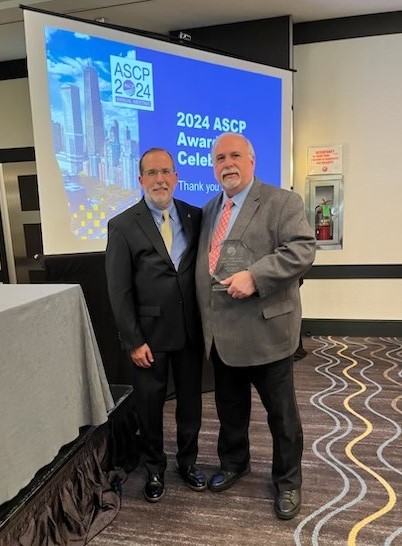Gene P. Siegal, M.D., Ph.D., Robert W. Mowry Endowed Professor and Executive Vice Chair, UAB Pathology, received the 2024 ASCP Philip Levine Award for Outstanding Research from the American Society for Clinical Pathology during the organization’s annual meeting September 3-6 in Chicago.
The award honors dedicated ASCP members who have made significant contributions to molecular pathology, immunohematology, and/or immunopathology. Established in 1969, it honors the late Phillip Levine, MD, FASCP, who made many contributions to pathology, including determining the etiology of Rh hemolytic disease of newborns.
“I am deeply honored to be recognized by my peers,” Siegal said in a release by ASCP. “ASCP is one of my major professional homes. ASCP unites laboratory professionals and pathologists—all of whom play a pivotal role to diagnostic medicine and the patient care team—under one umbrella.”  Dr. Robert Goulart, outgoing president, ASCP, presents Dr. Gene P. Siegal with the Philip Levin Award for Outstanding Research.
Dr. Robert Goulart, outgoing president, ASCP, presents Dr. Gene P. Siegal with the Philip Levin Award for Outstanding Research.
“This award is an important recognition of Dr. Siegal’s contributions to pathology research throughout his career by one of the world’s preeminent pathology societies,” says Cristina Magi-Galluzzi, M.D., Ph.D., C. Bruce Alexander Endowed Professor and Chair, UAB Pathology.
Siegal has served on UAB Pathology faculty for more than 30 years, most recently as interim chair of the department. He is the president of the International Society of Bone and Soft Tissue Pathology (ISBSTP), and former president of ASCP. Siegal has served on approximately 30 academic journals on as an editorial board member or editor, including the American Journal of Clinical Pathology and as Editor-in-Chief of the United States and Canadian Academy of Pathology’s journalLab Investigation.
In 2021 Siegal was named a UAB Distinguished Professor; in 2015 he received the American Society of Investigative Pathology’s Distinguished Educator Award, and in 2017 the College of American Pathology’s Lifetime Achievement Award. In 2022 he was awarded the designation of “Mastership” from ASCP at the organization’s 100th annual meeting.
Siegal joined UAB in 1990 and was critical to building the department’s internationally recognized educational program, which has successfully trained a vast number of medical and graduate students, residents, and fellows. Best known for his experimental work in tumor invasion and metastasis in breast cancer, as well as for gene therapy, he has held dozens of grants over his professional career, generating many important research discoveries. He holds professorships in four UAB departments and is a founding member of many Centers on campus. He has lectured more than 150 times around the world and given 6 named lectures.
From the ASCP release:
“In his initial exposure to science as a cancer biologist, he sought to understand how in vitro transformation was driven by both chemical carcinogens and viruses as he sought to examine, by both biochemical means and mathematical modeling, how mRNA moved from nuclear precursor forms to mature polysomal products. He further sought to apply biochemical strategies to tumor invasion and metastasis, mainly focusing on breast cancer as the model system. This led to important insights. Among them, he was among the first to show how cancer cells invade by using metalloproteases to transgress basement membranes. He also explored how coagulation factors influenced these processes and how viral associated factors could enhance, rather than inhibit, the ability of tumor cells to spread in the host.
In the early years of his first faculty position, he sought to blend the many skills, techniques, and concepts he had begun to master in molecular biology, biochemistry, cancer physiology, and surgical pathology and apply them to develop new experimental models in novel ways, utilizing immunohistochemistry with antibodies directed against extracellular matrix components in unique tumor types.
In the mid-1990s, he radically changed the focus of his research to embrace cancer gene therapy and virotherapy. This allowed him to return to his roots while tying his research and clinical interests more tightly together. To that end, his group was among the first to demonstrate the clinical utility of this approach and successfully carried out several bench-to-bedside clinical trials. Furthermore, he and his group demonstrated the value of using canine models of human bone diseases. This work has continued at the interface of prostate and breast cancer metastasis to bone to better understand the mechanisms of neoplastic progression in general and the factors that target bone in particular. ”